catalogue
What values in the PE file will be affected by the new section?
If you need to build a shellcode at one end in the PE file (when the remaining space in the default section area is insufficient), you can solve this problem by adding a section. Usually, most shelling software will add a section to move or back up various directory item data
What values in the PE file will be affected by the new section?
- IMAGE_FILE_HEADER → numberofsections (the current number of PE file sections. If a new section is added, this value needs to be corrected)
- IMAGE_OPTIONAL_HEADER → sizeofimage (the size in memory after adding a section needs to be corrected)
- In the default last IMAGE_SECTION_HEADER After that, add a section table structure and correct its data
To add a new section:
- By judgment IMAGE_OPTIONAL_HEADER → sizeofheaders (the size of all header + section table files aligned) to check whether there is enough space to add a section table data. If not, erase the DOS_STUB data and move nt and section data to DOS as a whole_ Stub position and correct IMAGE_DOS_HEADER → e_lfanew.
- Add a new section after the current last section IMAGE_SECTION_HEADER Structure, and modify its properties according to the size of the new section
- repair IMAGE_FILE_HEADER→NumberOfSections.
- repair IMAGE_OPTIONAL_HEADER → SizeOfImage.
- Reallocate the file cache of the corresponding size after adding
- Copy previous data
Add section manually
View the default properties of PE file through WinHex tool
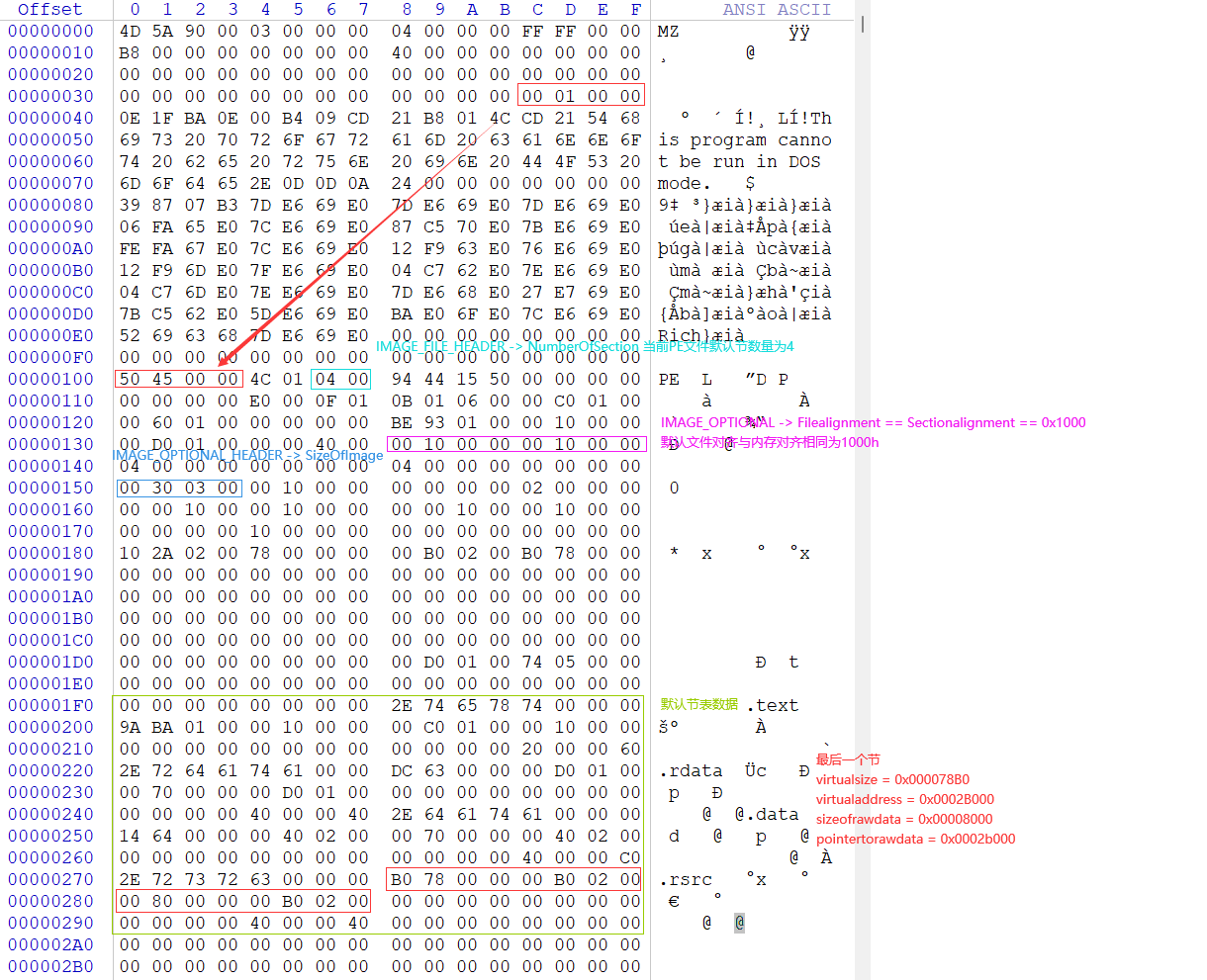
1) . judge whether the space is enough to add a new section
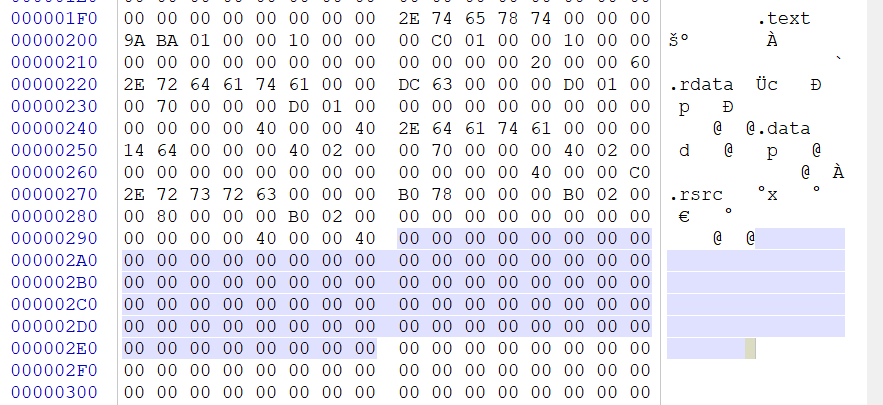
Currently, there is idle data of size of (image_section_header) * 2 (80byte) after the last section
2) . a section table structure is added at the last section
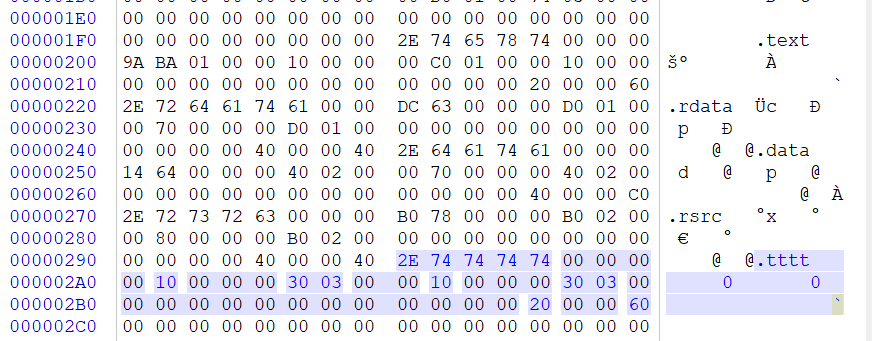
It is more convenient to set the size of memory and file to 0x1000 (the size in file is the size after file alignment)
The offset between memory and file is set to pointertorawdata + size of rawdata in the previous section
Section properties can be set according to actual requirements View the data point corresponding to this flag bit.
3) . repair IMAGE_FILE_HEADER→NumberOfSections.

4. Repair IMAGE_OPTIONAL_HEADER → SizeOfImage.
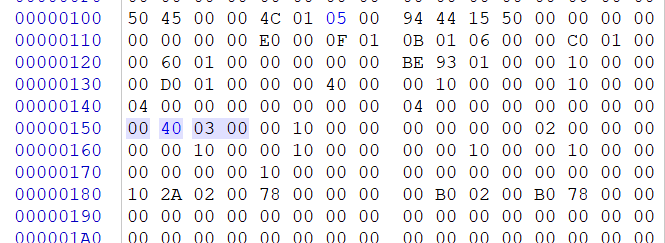
5. Add corresponding section data in the document
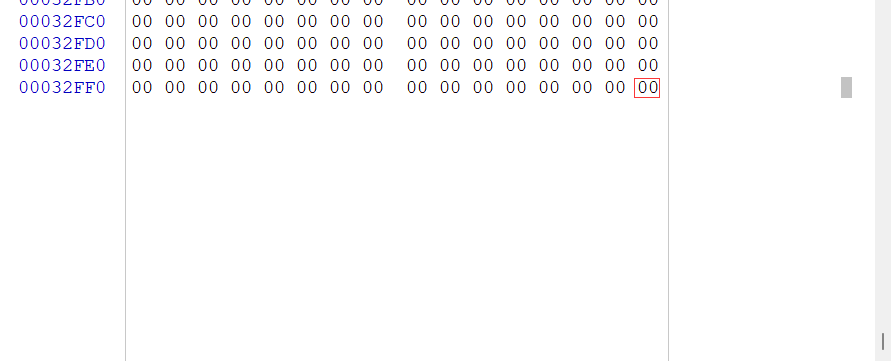
Move to the end of the file, select the last byte, select WinHex, edit in the menu bar, select the menu item, and paste 0 data
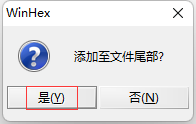
The new section size is 1000h, and the corresponding decimal system is 4096
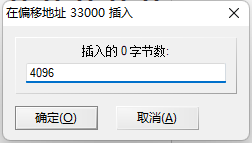
After adding data, save it as a file and view its data through PE tool
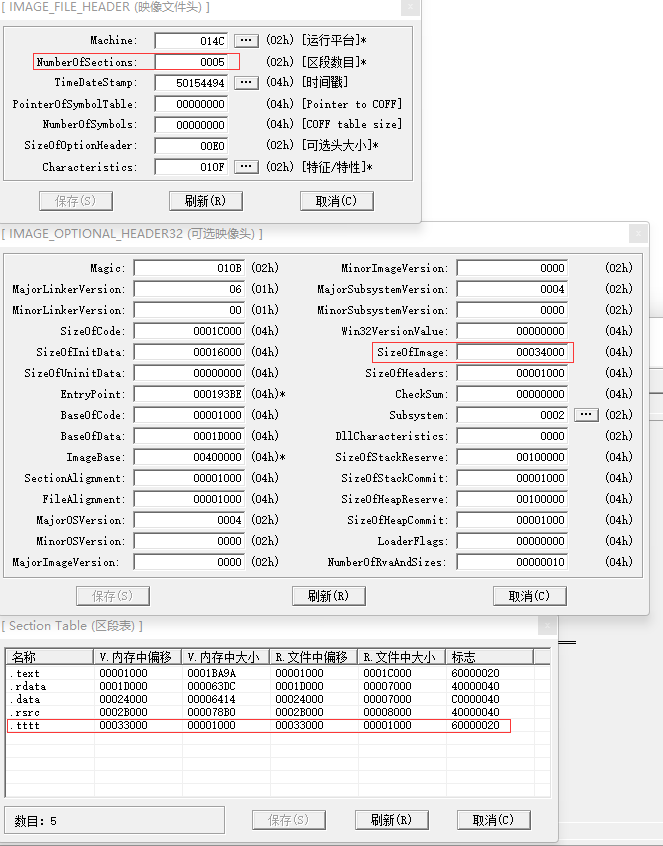
Whether the program can run normally knows whether the new section is successful or not
Code new section
Read file code
PVOID FileToMem(IN PCHAR szFilePath, OUT LPDWORD dwFileSize)
{
//Open file
FILE* pFile = fopen(szFilePath, "rb");
if (!pFile)
{
printf("FileToMem fopen Fail \r\n");
return NULL;
}
//Get file length
fseek(pFile, 0, SEEK_END); //SEEK_END file end
DWORD Size = ftell(pFile);
fseek(pFile, 0, SEEK_SET); //SEEK_ Start of set file
//Request to store file data buffer
PCHAR pFileBuffer = (PCHAR)malloc(Size);
if (!pFileBuffer)
{
printf("FileToMem malloc Fail \r\n");
fclose(pFile);
return NULL;
}
//Read file data
fread(pFileBuffer, Size, 1, pFile);
//Determine whether it is an executable file
if (*(PSHORT)pFileBuffer != IMAGE_DOS_SIGNATURE)
{
printf("Error: MZ \r\n");
fclose(pFile);
free(pFileBuffer);
return NULL;
}
if (*(PDWORD)(pFileBuffer + *(PDWORD)(pFileBuffer + 0x3C)) != IMAGE_NT_SIGNATURE)
{
printf("Error: PE \r\n");
fclose(pFile);
free(pFileBuffer);
return NULL;
}
if (dwFileSize)
{
*dwFileSize = Size;
}
fclose(pFile);
return pFileBuffer;
}Output file code
VOID MemToFile(IN PCHAR szFilePath, IN PVOID pFileBuffer, IN DWORD dwFileSize)
{
//Open file
FILE* pFile = fopen(szFilePath, "wb");
if (!pFile)
{
printf("MemToFile fopen Fail \r\n");
return;
}
//output file
fwrite(pFileBuffer, dwFileSize, 1, pFile);
fclose(pFile);
}New section code
PVOID AddNewSection(PCHAR pBuffer, DWORD dwSectionSize, LPDWORD pNewFileSize)
{
//Positioning structure
PIMAGE_DOS_HEADER pDos = (PIMAGE_DOS_HEADER)pBuffer;
PIMAGE_NT_HEADERS pNth = (PIMAGE_NT_HEADERS)(pBuffer + pDos->e_lfanew);
PIMAGE_FILE_HEADER pFil = (PIMAGE_FILE_HEADER)((PUCHAR)pNth + 4);
PIMAGE_OPTIONAL_HEADER pOpo = (PIMAGE_OPTIONAL_HEADER)((PUCHAR)pFil + IMAGE_SIZEOF_FILE_HEADER);
PIMAGE_SECTION_HEADER pSec = (PIMAGE_SECTION_HEADER)((PUCHAR)pOpo + pFil->SizeOfOptionalHeader);
//Judge whether there is space for adding new sections in the head
if (pBuffer + pOpo->SizeOfHeaders - &pSec[pFil->NumberOfSections + 1] < IMAGE_SIZEOF_SECTION_HEADER )
{
//Erase DOS_STUB data and move nt and section up
BOOL bRet = MoveNtAndSectionToDosStub(pBuffer);
if (!bRet)
{
printf("AddNewSection MoveNtAndSectionToDosStub Fail \r\n");
free(pBuffer);
return NULL;
}
pDos = (PIMAGE_DOS_HEADER)pBuffer;
pNth = (PIMAGE_NT_HEADERS)(pBuffer + pDos->e_lfanew);
pFil = (PIMAGE_FILE_HEADER)((PUCHAR)pNth + 4);
pOpo = (PIMAGE_OPTIONAL_HEADER)((PUCHAR)pFil + IMAGE_SIZEOF_FILE_HEADER);
pSec = (PIMAGE_SECTION_HEADER)((PUCHAR)pOpo + pFil->SizeOfOptionalHeader);
}
//Fill in new section data
CHAR szName[] = ".Kernel";
memcpy(pSec[pFil->NumberOfSections].Name, szName,8);
pSec[pFil->NumberOfSections].Misc.VirtualSize = dwSectionSize;//Size before alignment in memory
pSec[pFil->NumberOfSections].VirtualAddress = Align(pOpo->SectionAlignment, pSec[pFil->NumberOfSections - 1].Misc.VirtualSize + pSec[pFil->NumberOfSections - 1].VirtualAddress);//Offset in memory
pSec[pFil->NumberOfSections].SizeOfRawData = Align(pOpo->FileAlignment, dwSectionSize);//Aligned size in file
pSec[pFil->NumberOfSections].PointerToRawData = Align(pOpo->FileAlignment, pSec[pFil->NumberOfSections - 1].PointerToRawData + pSec[pFil->NumberOfSections - 1].SizeOfRawData);//Offset in file
pSec[pFil->NumberOfSections].PointerToRelocations = 0;
pSec[pFil->NumberOfSections].PointerToLinenumbers = 0;
pSec[pFil->NumberOfSections].NumberOfRelocations = 0;
pSec[pFil->NumberOfSections].NumberOfLinenumbers = 0;
pSec[pFil->NumberOfSections].Characteristics |= pSec->Characteristics;//Default code section
pSec[pFil->NumberOfSections].Characteristics |= 0xC0000040;
//The supplementary size after the new section is image_ SECTION_ 0 data of header structure
memset(&pSec[pFil->NumberOfSections + 1], 0, IMAGE_SIZEOF_SECTION_HEADER);
//Fix default number of sections
pFil->NumberOfSections++;
//Fix memory image size
pOpo->SizeOfImage += Align(pOpo->SectionAlignment, dwSectionSize);
//Default file size
DWORD dwOldSize = pSec[pFil->NumberOfSections - 2].SizeOfRawData + pSec[pFil->NumberOfSections - 2].PointerToRawData;
//Current file size
DWORD dwNewSize = pSec[pFil->NumberOfSections - 1].SizeOfRawData + pSec[pFil->NumberOfSections - 1].PointerToRawData;
if (pNewFileSize)
{
*pNewFileSize = dwNewSize;
}
//Reallocate buffer
PUCHAR pTemp = (PUCHAR)malloc(dwNewSize);
if (!pTemp)
{
printf("AddNewSection malloc Fail \r\n");
free(pBuffer);
return NULL;
}
memset(pTemp,0, dwNewSize);
memcpy(pTemp, pBuffer, dwOldSize);
free(pBuffer);
return pTemp;
}Test code
int main()
{
//Read file binary data
DWORD dwFileSize = 0;
PCHAR pFileBuffer = FileToMem(FILE_PATH_IN, &dwFileSize);
if (!pFileBuffer)
{
return;
}
//New section
pFileBuffer = AddNewSection(pFileBuffer, 0x2222, &dwFileSize);
//Output binary data to a file
MemToFile(FILE_PATH_OUT, pFileBuffer, dwFileSize);
return 0;
}